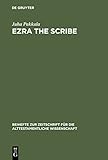Ezra the Scribe : The Development of Ezra 7-10 and Nehemia 8 / Juha Pakkala.
Material type: TextSeries: Beihefte zur Zeitschrift für die alttestamentliche Wissenschaft ; 347Publisher: Berlin ; Boston : De Gruyter, [2012]Copyright date: ©2004Edition: Reprint 2012Description: 1 online resource (345 p.)Content type:
TextSeries: Beihefte zur Zeitschrift für die alttestamentliche Wissenschaft ; 347Publisher: Berlin ; Boston : De Gruyter, [2012]Copyright date: ©2004Edition: Reprint 2012Description: 1 online resource (345 p.)Content type: - 9783110182804
- 9783110915624
- 222/.7066 22
- BS1355.52 .P35 2004eb
- online - DeGruyter
- Issued also in print.
| Item type | Current library | Call number | URL | Status | Notes | Barcode | |
|---|---|---|---|---|---|---|---|
 eBook
eBook
|
Biblioteca "Angelicum" Pont. Univ. S.Tommaso d'Aquino Nuvola online | online - DeGruyter (Browse shelf(Opens below)) | Online access | Not for loan (Accesso limitato) | Accesso per gli utenti autorizzati / Access for authorized users | (dgr)9783110915624 |
Frontmatter -- Acknowledgements -- Contents -- Abbreviations -- 1. INTRODUCTION -- 2. EZRA 7–8 -- 3. EZRA 9–10 -- 4. NEH 8 -- 5. NEH 9–1 0 – LATE FORTSCHREIBUNG OF THE EZRA MATERIAL -- 6. NEH 13 -- 7. DEVELOPMENT OF THE EZRA MATERIAL -- 8. THE EZRA MATERIAL AND THE TORAH -- 9. SUMMARY -- Appendix A: The Main Editorial Phases -- Appendix Β: Literary Strata of the Ezra Material -- Appendix C: Reconstructed Text of the Ezra Source -- Appendix D: The Editorial Phases of the EM in Translation -- Bibliography -- Index of Hebrew and Aramaic Words and Phrases -- Subject Index -- Author Index -- Index of Ancient Sources
restricted access online access with authorization star
http://purl.org/coar/access_right/c_16ec
Die Textentwicklung von Esra 7-10 und Nehemia 8 zeigt mehrere Bearbeitungsstufen: In der ältesten Schicht wird Esra als Schriftgelehrter, in späteren Stufen als Priester dargestellt. Die Endgestalt des Textes steht für historische Fragestellungen nicht zur Verfügung. Der ursprüngliche Einfluss von Deuteronomium und (deutero)nomistischer Theologie wurde von priesterlichem und levitischem Einfluss überlagert.
This monograph investigates the literary development of Ezra 7-10 and Neh 8. With a detailed literary critical analysis, the investigation shows that the text was produced in several successive editorial phases for at least two centuries. Thus the final text cannot be used for historical purposes. The oldest text emerged as a short narrative, entirely written in the third person. It describes how a Torah scribe (Schriftgelehrter) called Ezra came from Babylon to Jerusalem to reinstate the written Torah. In the later editorial phases, Ezra's role was transformed from a scribe to a priest who brought cultic vessels to the Temple. The editorial development reveals that the text was originally influenced by Deuteronomy and the (Deutero)nomistic theology. Later, it came under priestly and Levitical influence.
Issued also in print.
Mode of access: Internet via World Wide Web.
In English.
Description based on online resource; title from PDF title page (publisher's Web site, viewed 28. Feb 2023)


